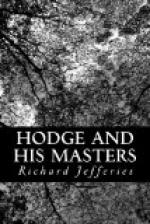There is good reason, from an agricultural point of view, for this. The district, with its capital city, Fleeceborough, really is distinct, well marked, and defined. The very soil and substrata are characteristic. The products are wheat, and cattle, and sheep, the same as elsewhere, but the proportions of each, the kind of sheep, the traditionary methods and farm customs are separate and marked. The rotation of crops is different, the agreements are on a different basis, the very gates to the fields have peculiar fastenings, not used in other places. Instead of hedges, the fields, perhaps, are often divided by dry stone walls, on which, when they have become old, curious plants may sometimes be found. For the flora, too, is distinct; you may find herbs here that do not exist a little way off, and on the other hand, search how you will, you will not discover one single specimen of a simple flower which strews the meadows elsewhere.
Here the very farmhouses are built upon a different plan, and with different materials; the barns are covered with old stone slates, instead of tiles or thatch. The people are a nation amongst themselves. Their accent is peculiar and easily recognised, and they have their own folklore, their own household habits, particular dainties, and way of life. The tenant farmers, the millers, the innkeepers, and every Hodge within ‘the uplands’ (not by any means all hills)—in short, every one is a citizen of Fleeceborough. Hodge may tend his flock on distant pastures, may fodder his cattle in far-away meadows, and dwell in little hamlets hardly heard of, but all the same he is a Fleeceborough man. It is his centre; thither he looks for everything.
The place is a little market town, the total of whose population in the census records sounds absurdly small; yet it is a complete world in itself; a capital city, with its kingdom and its ruler, for the territory is practically the property of a single family. Enter Fleeceborough by whichever route you will, the first object that fixes the attention is an immensely high and endless wall. If you come by carriage




